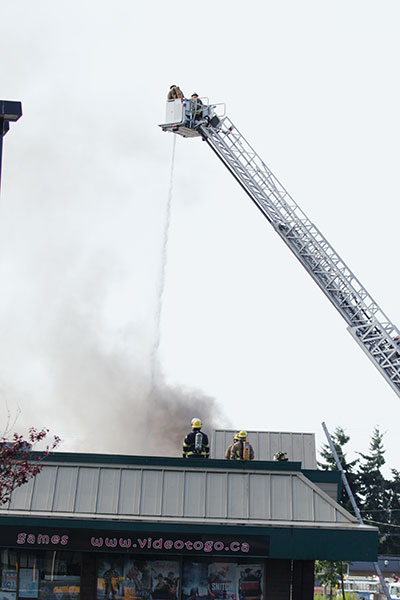
Features
Hot topics
Incident reports
A model of mutual aid
It was the last day in July of a perfect summer, and the Greater Victoria area was about to break a record for the first month ever recorded with no precipitation.
November 22, 2013
By Steve Sorensen
It was the last day in July of a perfect summer, and the Greater Victoria area was about to break a record for the first month ever recorded with no precipitation. The hot, dry weather brought the usual assortment of emergency calls for the Sooke Fire Rescue Service, including many bark mulch fires as a result of carelessly discarded cigarettes. So when the pagers went off at 5:27 a.m. for smoke coming from the ground at Evergreen Mall, the duty officer expected just another routine call.
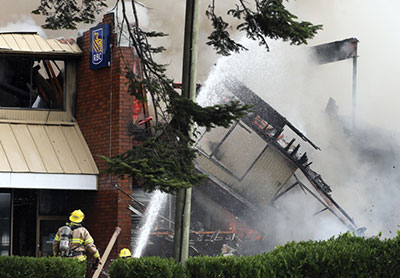
|
|
| Despite several collapses in the two-storey building during the fire, good communication ensured that no firefighters were injured. Photo By Adrian Lam
|
While en route, however, expectations rapidly changed. Dispatch came back on the air just three minutes later to report a second 911 call reporting smoke inside the Royal Bank, visible from inside the after-hours ATM room.
The bank was located on the east end of the ground floor of a two-storey, wood-framed commercial strip mall that had been built in 1976; it was the first of six buildings that currently sit on this site. The building measured 50 metres (164 feet) long and 18 metres (60 feet) wide. Built on a concrete slab, the exterior and interior walls were wood-framed with a stucco finish. The first floor contained open-chord wood trusses with a suspended ceiling below and two-centimetre (three-quarter-inch) plywood with a five-centimetre (two-inch) concrete topping. The roof was constructed using the same type of wood trusses, a drywall ceiling and a tar-and-gravel roof finish over plywood decking. The ground floor contained six storefronts including the bank, all with front entrances to the adjacent parking lot. The second storey was accessible by a centre staircase. A hallway ran the length of the second floor, with offices to the front and rear of the building and a fire exit stairwell at each end of this corridor. At the time of the fire, there were three businesses on the main floor, with the Royal Bank occupying two suites. The other two main-floor occupancies were an insurance broker and the local newspaper office. The second floor contained a large computer software firm in the front and a dance studio at the rear. The remaining suites were vacant at the time of the fire.
With the second 911 report on the fire, a general alarm was sounded for Sooke firefighters. The duty officer arrived on scene at 5:36 a.m., reporting light smoke coming from both floors, and a mutual-aid request was made for the Otter Point Volunteer Fire Department. Upon the completion of a 360-degree size-up, and knowing of the limited volunteer response, the duty officer made a second mutual-aid request for the Metchosin Fire Department (also volunteer) at 5:39 a.m. Command was transferred to Car 1 (the fire chief) upon his arrival at 5:40 a.m. Just two minutes later, Ladder 1, the first Sooke apparatus to arrive, pulled into the east driveway and immediately began pulling a one-and-three-quarter-inch pre-connect. As Ladder 1 crews made entry to the bank, Engine 1 arrived on scene using the west entrance of the mall, picking up a hydrant in the parking lot and establishing a water supply, a staging area, and took on the role of RIT. Engine 2 was next on scene at 5:49 a.m. and laid in another four-inch supply line to feed Ladder 1 from another hydrant adjacent to the parking lot of the east exposure.
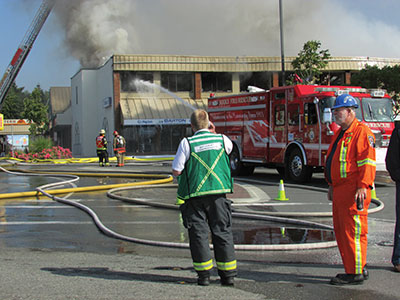 |
|
| Incident commander Steve Sorensen examines the progress of suppression efforts. Following the extensive investigation, it was determined that the July 31 fire had been deliberately set, and caused $5.5 million in damages. Photo by Derek Lewers |
Entry crews had a difficult time accessing the interior of the bank due to security bars and had to force entry. The fire appeared to be concentrated at the rear (Charlie) side of the bank. As crews entered the building, they reported heavy smoke with fire in the walls and ceiling of a storage room. Members of the Otter Point department arrived on scene at 5:58 a.m. with an engine company and assumed RIT duties; Engine 1 crews were sent to the second floor to check for extension above the bank. The Metchosin Fire Department arrived a few minutes later and reported in. By this time, interior crews had notified command that they had knocked down the main body of fire in the bank and were conducting overhaul and required ventilation to be set up. In the meantime, Attack 2 on the second floor reported extremely heavy smoke above the bank and began to remove windows to improve visibility. At this point, Attack 1 in the Royal Bank had a low air alarm sounding on an SCBA and exited the building. The crew from Otter Point then took over duties of Attack 1 to finish overhauling the fire area. As the crew entered the bank, a large section of the suspended ceiling collapsed in front of them. Meanwhile, Attack 2 reported heat building up in the Charlie/Delta section of the second floor.
With the situation deteriorating, another mutual-aid request was made to East Sooke Fire Department at 6:16 a.m. Metchosin then offered to send a second engine and the Shirley Volunteer Fire Department offered to respond with an engine from its department. These offers were accepted.
With the ceiling collapse, Attack 1 moved out of the bank and re-entered the suite from another entry point, an exterior door further along the building’s frontage. Heavy smoke was now visible from soffits along the entire length of the second floor. As additional units arrived, crews began to perform salvage work in the main floor occupancies not yet involved in fire. With the fire now spreading in the bank’s rear wall, firefighters worked to access the main body of fire by cutting through the exterior wall to gain entry to the bank’s storage room. Once opened, heavy fire was reported in the wall and ceiling space. With the situation still deteriorating and personnel rapidly being used up, another mutual-aid request was made to the Langford Fire Department for an engine company to respond. At 6:52 a.m., Assistant Chief Matt Barney of Sooke Fire reported a possible wall collapse within the bank and the floor beginning to sag. While no firefighters were working in this area due to the previous ceiling collapse, an accountability check was completed with all firefighters reporting in. Crews on the second floor also had been previously cleared from this general area.
Trying to get ahead of the fire, a roof team was sent to cut a ventilation hole at the mid-point of the building to determine if the fire was spreading laterally through the roof trusses and to assist in ventilation. With additional engine companies on scene and the fire spreading rapidly, the water supply was at capacity. A decision was made to connect to two more fire hydrants. However, as these were located on the opposite side of Highway 14, which runs through the centre of town, this involved a complete shutdown of the road. RCMP officers and Ministry of Transportation workers set up detours.
Sooke Fire Rescue Service
|
With the additional water supply secured, there were now four teams of firefighters in the building trying to gain an upper hand on the fire, with another crew on the roof. Salvage operations were well underway and two rapid intervention teams were setting up extra equipment. With the increasing number of personnel arriving – now nearing 50 firefighters on scene – accountability became a major challenge for the command staff. At 6:52 a.m., a serious collapse of the second floor into the bank occurred in the area that had already been declared off limits. The remaining interior crews were reporting deteriorating conditions. Heavy smoke began pushing out the length of the building. Firefighters still hoped to stop the spread of fire to the west end of the building. At 7:09 a.m., the roof crew reported heavy smoke issuing from their ventilation hole and interior crews reported smoke and heat levels rising on the second floor. At 7:12 a.m., another collapse occurred in the Royal Bank section of the building. With conditions continuing to deteriorate and the fire spreading, all crews were ordered out of the building. The ladder was set up for a defensive attack from above while crews prepared large lines and master stream devices on the Alpha and Charlie sides. Another mutual-aid call was placed to the Langford Fire Department for its tower ladder to respond. As the fire took hold, crews mounted an all-out assault to keep the fire from spreading to the adjoining liquor store and other mall buildings, as well as to the adjacent Home Hardware store on the Charlie exposure.
With the arrival of the Langford tower ladder, more than 5,000 gallons-per-minute of water was being used to keep the fire in check. It was then that command was informed that, at the rate the water was being applied, there was only about another hour of water left in the reservoir. It was later determined that homes in higher elevations were already noting a drop in their water pressure. An excavator was brought in to assist in reaching areas not accessible to firefighters. With all this effort, the fire began to subside and the scene was gradually brought under control. Attention switched to dealing with pockets of hidden fire and helping merchants in other stores within the mall to deal with smoke and ash that had been drawn into their shops through HVAC systems. Just before 11 a.m., the fire loss was declared stopped and some mutual-aid units began to pack up and head for home. By 12 p.m., two of the hydrants were shut down and the highway was reopened to traffic.
Later that day, Langford Fire sent another engine to assist Sooke firefighters with overhaul and cleanup. The majority of crews cleared the scene by 6 p.m. and returned to the station to begin a major cleanup of apparatus, gear and equipment. The last firefighter was out the door at 9:30 p.m. – 16 hours after the incident began.
With the fire out, the lengthy investigation process began. Given that multiple insurance companies were involved in this fire, two investigators were sent to help Sooke Fire Rescue determine the cause and origin. As the fire was deemed suspicious from the start, the RCMP had a major presence, including a canine unit during the actual fire, followed by detectives and forensic identification members after the fire was out. Thanks to a good initial size-up of the fire scene at the beginning of the incident and photographic evidence, the area of origin was quickly established as being at the rear exterior of the Royal Bank.
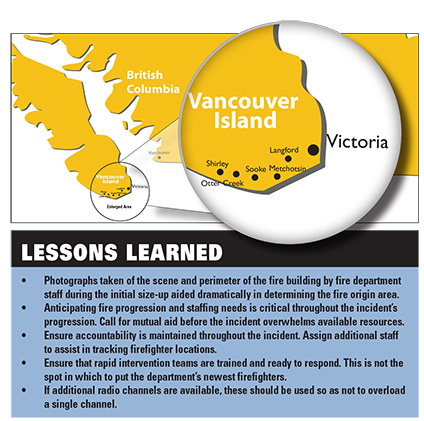 |
|
Based on evidence gathered, the investigation team decided to attempt to recreate the fire a few days later. It was concluded that a plastic wheeled garbage tote containing recycled paper was the origin of the fire and that the fire had been deliberately set. There was sufficient heat generated to preheat the wall surface, along with molten plastic from the bin flowing up against the building to ignite the plywood sheathing and building paper. From there, the fire travelled up the stud cavity, behind the insulation, and into the ceiling space and the open wooden trusses. With no fire stop, there was nothing to slow down the fire spread as it continued up the wall to the attic trusses as well as across the length of the floor. Total losses were about $5.5 million. The property owners have vowed to rebuild.
Community support throughout this ordeal was tremendous with many restaurants and shops providing food and drink to all the responders. The Royal Bank and mall merchants, just two weeks later, organized a thank-you barbecue for all the emergency personnel and provided a $6,000 donation to the fire department for the purchase of individual SCBA masks for the firefighters. Three weeks after the fire, Sooke Fire Rescue Service celebrated its 100th anniversary with a parade and fire-truck muster. Hundreds of residents attended the event to show their support. Another of the mall merchants affected by the fire provided a chicken and ribs barbecue to all the personnel who helped to save his store from the fire. It was a very proud day to be a firefighter in Sooke.
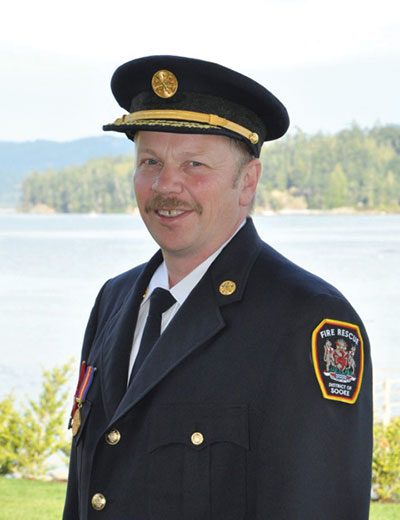
|
|
Steven Sorensen joined the Sooke Fire Rescue Service as a volunteer firefighter in 1983. In 1997, he was appointed full-time training officer, and in 2000 was promoted to deputy chief, taking over the fire-prevention division. Sorensen became fire chief and emergency co-ordinator in 2010. Contact him at ssorensen@sooke.ca
Print this page
